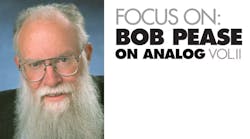This article is in Bob Pease on Analog Volume 2 in the Analog section of the Electronic Design Library.
Members can download the PDF ebook.
I was down at an "Arrowfest" in Plano, Texas, a few months ago. We had a little panel session about the future with Bill Klein of Texas Instruments, Arnold Williams from Analog Devices, and myself. Most of the audience agreed with the three of us (and the moderator)—the future will have a lot of analog.
When we see that the power-supply drain of a fast processor at 0.09 µm is largely related to the device leakages—which aren't very predictable and can't be modeled easily—hey, that processor is relying on analog characteristics.
Remember the old days, when engineers were struggling to bias up germanium transistors so their bias wouldn't suffer from thermal runaway? Now, the silicon circuits are on the verge of thermal runaway.
It will take some good, tough engineering to solve the layout and heating problems. Maybe when they turn off the clocks to some subsystems, that area of the chip will stop selfheating, the temperature will go down, and the leakage will decrease—a kind of thermal un-runaway.
I wonder what Moore's Law has to say about that. Obviously, when the "process" goes down to 0.065 µm, it will get much worse. Now that designers can't keep shrinking things, the digital field is going to look a lot different. What will they sell us next year? Microprocessors that aren't just fast battery dischargers?
Future Power People are still bringing up the old saying that "Fuel cells are the power source of the future—and always will be." Down here in Silicon Valley, the Transit Authority operates a couple of busses running on fuel cells. This is an ideal area, because it's so flat with very few hills. (They'd never cut it in San Francisco.) From what I hear, the fuel cells have a very finite life and will need to be replaced every few months. And they're expensive! I'm waiting to hear how those busses work out.Engineers, scientists, and chemists have been trying for many years to reduce the price of fuel cells by an order of magnitude or two. Great! NASA is very happy to pay for such exotic energy sources. Now the fuel-cell makers only have to improve the cells by three or four more orders of magnitude before they fit into future cars.
Are high-efficiency solar panels headed for a big future? I've seen studies that say inexpensive (not-so-highefficiency) solar arrays are the right way to make cost-effective energy. It's fine by me, if the cost of a watt keeps going down. Mr. Ovshinsky of Energy Conversion Devices (ECD) has been saying that for years, and people are starting to follow him.
Furthermore, people are beginning to see that nuclear power plants have a future. It's better than pretending we can buy cheap oil forever. Besides, nuclear power has a much more reliable availability factor than solar power or wind power. All we have to do is get the politicians to agree to hide the nuclear spoils where they won't contaminate us and poison us all.
And maybe this time, we can make sure the shale-oil conversion experts get going and keep going. The U.S. has enough oil-shale to last us many decades into the future for a large fraction of our energy needs. We only have to prove that we can rely on it at plausible, reasonable price— chop the support for that when the oil shock decreases.
So while I'm not very good at predicting the future, lots of other people are predicting good things! I just hope I'll be hanging around for many more years to smile at them when they get here! Nuclear-powered op amps, anyone?
Comments invited! [email protected] —or: Mail Stop D2597A, National Semiconductor P.O. Box 58090, Santa Clara, CA 95052-8090

